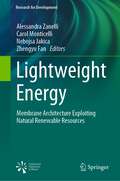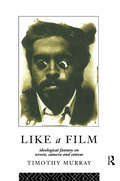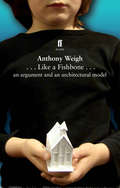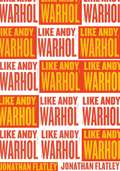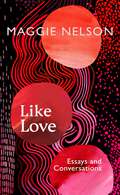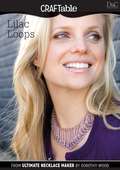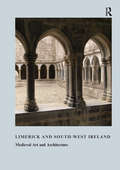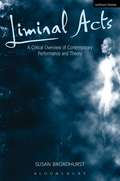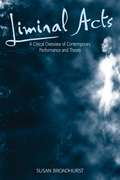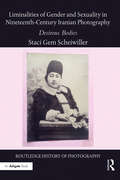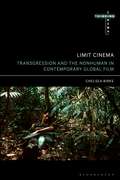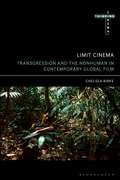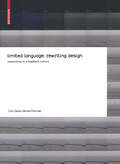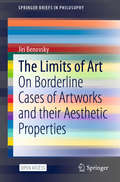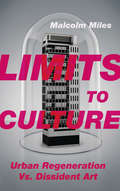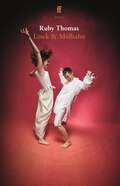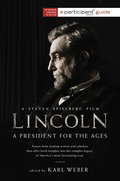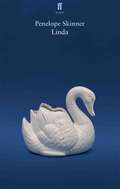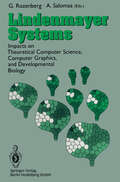- Table View
- List View
Lightweight Energy: Membrane Architecture Exploiting Natural Renewable Resources (Research for Development)
by Alessandra Zanelli Carol Monticelli Nebojsa Jakica Zhengyu FanThis book explores membrane materials as a means of translating natural and renewable resources into a more flexible, dynamic, and reactive architectural skin. It represents the first time that energy-saving design has been addressed systematically in relation to lightweight building systems and tensile membranes. Understanding of the energetic behavior of membranes and foils used as a building envelope is a fundamental theme, as it is the integration of flexible photovoltaics in membranes, as well as the exploitation of water and wind resources. A theoretical, methodological framework for consciously designing the membrane life cycle is presented. The authors cross-cut and combine exploration of climate-based design methodology and life cycle thinking strategies. Both active and passive systems are investigated, referring to alternative productive resources like sun, wind, and water. Case studies are brought forward in the book’s second half, highlighting energy lightness for an increasingly dematerialized architecture and addressing inherent issues. Four main research and development paths are presented, the first two focusing on advancements in façade materials and Photovoltaic systems applicable to membrane architecture, the third referring to fog and dew harvesting and the fourth dealing with the future frontier of flexible transparency and designs for well-being through a passive solar system.
Like a Film: Ideological Fantasy on Screen, Camera and Canvas
by Timothy MurrayIn this stimulating collection of theoretical writings on film, photography, and art, Timothy Murray examines relations between artistic practice, sexual and racial politics, theory and cultural studies. Like a Film investigates how the cinematic apparatus has invaded the theory of culture, suggesting that the many destabilising traumas of our culture remain accessible to us because they are structured so much like film. The book analyses the impact of cinematic perceptions and productions on awide array of cultural practices: from the Renassance works of Shakespeare and Caravaggio to modern sexual and political fantasy; and the theoretical work of Lyotard, Torok, Barthes, Ropars-Wuilleumier, Zizek, Silverman and Laplanche.Like A Film responds to current multicultural debates over the value of theory and the aim of artistic practice.
Like a Film: Ideological Fantasy on Screen, Camera and Canvas
by Timothy MurrayIn this stimulating collection of theoretical writings on film, photography, and art, Timothy Murray examines relations between artistic practice, sexual and racial politics, theory and cultural studies. Like a Film investigates how the cinematic apparatus has invaded the theory of culture, suggesting that the many destabilising traumas of our culture remain accessible to us because they are structured so much like film. The book analyses the impact of cinematic perceptions and productions on awide array of cultural practices: from the Renassance works of Shakespeare and Caravaggio to modern sexual and political fantasy; and the theoretical work of Lyotard, Torok, Barthes, Ropars-Wuilleumier, Zizek, Silverman and Laplanche.Like A Film responds to current multicultural debates over the value of theory and the aim of artistic practice.
Like a Fishbone: An argument and an architectural model (Currency Theatre Ser.)
by Anthony WeighA remote valley. An unspeakable crime. A prominent architect is commissioned to design a memorial. On the evening of its presentation, a blind woman comes out of the rain and into the architect's studio. She is the mother of one of the victims and demands to be heard. Over the next two hours the women do battle over what it means to memorialise the dead, what it means to be a mother and what it means to believe.
Like Andy Warhol
by Jonathan FlatleyScholarly considerations of Andy Warhol abound, including very fine catalogues raisonné, notable biographies, and essays in various exhibition catalogues and anthologies. But nowhere is there an in-depth scholarly examination of Warhol’s oeuvre as a whole—until now. Jonathan Flatley’s Like Andy Warhol is a revelatory look at the artist’s likeness-producing practices, not only reflected in his famous Campbell’s soup cans and Marilyn Monroe silkscreens but across Warhol’s whole range of interests including movies, drag queens, boredom, and his sprawling collections. Flatley shows us that Warhol’s art is an illustration of the artist’s own talent for “liking.” He argues that there is in Warhol’s productions a utopian impulse, an attempt to imagine new, queer forms of emotional attachment and affiliation, and to transform the world into a place where these forms find a new home. Like Andy Warhol is not just the best full-length critical study of Warhol in print, it is also an instant classic of queer theory.
Like Love: Essays and Conversations
by Maggie NelsonA CAREER-SPANNING COLLECTION OF INSPIRING, REVELROUS ESSAYS ABOUT ART AND ARTISTS'Like Love may be one of the most movingly specific, the most lovingly unruly celebrations of the ethics of friendship we have' Guardian'A polyphonic assemblage . . . graceful and aesthetic, deftly crossing boundaries and definitions, a concordant symphony' Irish TimesLike Love is a momentous, raucous collection of essays drawn from twenty years of Maggie Nelson's brilliant work. These profiles, reviews, remembrances, tributes and critical essays, as well as several conversations with friends and idols, bring to life Nelson's passion for dialogue and dissent. The range of subjects is wide - from Prince to Carolee Schneemann to Matthew Barney to Lhasa de Sela to Kara Walker - but certain themes recur: intergenerational exchange; love and friendship; feminist and queer issues, especially as they shift over time; subversion, transgression and perversity; the roles of the critic and language in relation to visual and performance arts; forces that feed or impede certain bodies and creators; and the fruits and follies of a life spent devoted to making.Arranged chronologically, Like Love shows the writing, thinking, feeling, reading, looking and conversing that occupied Nelson while writing iconic books such as Bluets and The Argonauts. As such, it is a portrait of a time, an anarchic party rich with wild guests, a window into Nelson's own development and a testament to the profound sustenance offered by art and artists.
The Likeness of the King: A Prehistory of Portraiture in Late Medieval France
by Stephen PerkinsonAnyone who has strolled through the halls of a museum knows that portraits occupy a central place in the history of art. But did portraits, as such, exist in the medieval era? Stephen Perkinson’s The Likeness of the King challenges the canonical account of the invention of modern portrait practices, offering a case against the tendency of recent scholarship to identify likenesses of historical personages as “the first modern portraits.” Unwilling to accept the anachronistic nature of these claims, Perkinson both resists and complicates grand narratives of portraiture art that ignore historical context. Focusing on the Valois court of France, he argues that local practice prompted shifts in the late medieval understanding of how images could represent individuals and prompted artists and patrons to deploy likeness in a variety of ways. Through an examination of well-known images of the fourteenth- and early fifteenth-century kings of France, as well as largely overlooked objects such as wax votive figures and royal seals, Perkinson demonstrates that the changes evident in these images do not constitute a revolutionary break with the past, but instead were continuous with late medieval representational traditions. “A lively, well-researched, and insightful work of scholarship on late-medieval portraiture and its cultural and intellectual context. The Likeness of the King provides a strong account of late-medieval aesthetics and specific, concrete examples of image-making and the often political needs it served. It offers smart handling of literary, philosophical, and archival sources; close and insightful reading of images; and a willingness to counter received ideas.”—Rebecca Zorach, University of Chicago
Lilac Loops
by Editors of D&CThis elegant seed bead necklace, inspired by a 1930s example, was complicated to design but is actually extremely easy to make. The bead loops are simply added one at a time to a base
Lilac Loops
by Editors of D&CThis elegant seed bead necklace, inspired by a 1930s example, was complicated to design but is actually extremely easy to make. The bead loops are simply added one at a time.
Limerick and South-West Ireland: Medieval Art and Architecture
by Roger StalleyThis book contains essays devoted to the medieval art and architecture of Limerick in the Munster province of South-West Ireland. It underpins the degree to which Irish craftsmen and builders engaged with the rest of Europe, and the nature of their relationship with English practice.
Limerick and South-West Ireland: Medieval Art and Architecture
by Roger StalleyThis book contains essays devoted to the medieval art and architecture of Limerick in the Munster province of South-West Ireland. It underpins the degree to which Irish craftsmen and builders engaged with the rest of Europe, and the nature of their relationship with English practice.
Liminal Acts: A Critical Overview of Contemporary Performance and Theory
by Susan BroadhurstThe term liminal refers to a marginalized space of fertile chaos and creative potential where nothing is fixed or certain. Liminal performance is an emerging genre which has surfaced only in recent times and describes a range of interdisciplinary, highly experimental, performative works in theatre and performance, film and music-performances which can be seen to prioritize the body, the technological and the primordial. Broadhurst argues that traditional and contemporary critical and aesthetic theories are ultimately deficient in interpreting liminal performance. This revolutionary work first surveys traditional aesthetics in the writings of Kant, Nietzsche and Heidegger and juxtaposes them with contemporary aesthetics in the writings of Foucault, Derrida, Baudrillard and Lyotard. A series of case studies follows and, Broadhurst concludes with a summary description of liminal performances as an emerging genre. Works discussed in detail include: Pina Bausch's Tanztheater, the innovative Theatre of Images of Robert Wilson and Philip Glass, the controversial social sculptures of the Viennese Actionists, Peter Greenaway's painterly aesthetics, Derek Jarman's queer politics, digitized sampled music, and neo-gothic sound.
Liminal Acts: A Critical Overview of Contemporary Performance and Theory
by Susan BroadhurstThe term liminal refers to a marginalized space of fertile chaos and creative potential where nothing is fixed or certain. Liminal performance is an emerging genre which has surfaced only in recent times and describes a range of interdisciplinary, highly experimental, performative works in theatre and performance, film and music-performances which can be seen to prioritize the body, the technological and the primordial. Broadhurst argues that traditional and contemporary critical and aesthetic theories are ultimately deficient in interpreting liminal performance. This revolutionary work first surveys traditional aesthetics in the writings of Kant, Nietzsche and Heidegger and juxtaposes them with contemporary aesthetics in the writings of Foucault, Derrida, Baudrillard and Lyotard. A series of case studies follows and, Broadhurst concludes with a summary description of liminal performances as an emerging genre. Works discussed in detail include: Pina Bausch's Tanztheater, the innovative Theatre of Images of Robert Wilson and Philip Glass, the controversial social sculptures of the Viennese Actionists, Peter Greenaway's painterly aesthetics, Derek Jarman's queer politics, digitized sampled music, and neo-gothic sound.
Liminalities of Gender and Sexuality in Nineteenth-Century Iranian Photography: Desirous Bodies (Routledge History of Photography)
by Staci Gem ScheiwillerNineteenth-century Iran was an ocularcentered society predicated on visuality and what was seen and unseen, and photographs became liminal sites of desire that maneuvered "betwixt and between" various social spaces—public, private, seen, unseen, accessible, and forbidden—thus mapping, graphing, and even transgressing those spaces, especially in light of increasing modernization and global contact during the nineteenth and early twentieth centuries. Of primary interest is how photographs negotiated and coded gender, sexuality, and desire, becoming strategies of empowerment, of domination, of expression, and of being seen. Hence, the photograph became a vehicle to traverse multiple locations that various gendered physical bodies could not, and it was also the social and political relations that had preceded the photograph that determined those ideological spaces of (im)mobility. In identifying these notions in photographs, one may glean information about how modern Iran metamorphosed throughout its own long durée or resisted those societal transformations as a result of modernization.
Liminalities of Gender and Sexuality in Nineteenth-Century Iranian Photography: Desirous Bodies (Routledge History of Photography)
by Staci Gem ScheiwillerNineteenth-century Iran was an ocularcentered society predicated on visuality and what was seen and unseen, and photographs became liminal sites of desire that maneuvered "betwixt and between" various social spaces—public, private, seen, unseen, accessible, and forbidden—thus mapping, graphing, and even transgressing those spaces, especially in light of increasing modernization and global contact during the nineteenth and early twentieth centuries. Of primary interest is how photographs negotiated and coded gender, sexuality, and desire, becoming strategies of empowerment, of domination, of expression, and of being seen. Hence, the photograph became a vehicle to traverse multiple locations that various gendered physical bodies could not, and it was also the social and political relations that had preceded the photograph that determined those ideological spaces of (im)mobility. In identifying these notions in photographs, one may glean information about how modern Iran metamorphosed throughout its own long durée or resisted those societal transformations as a result of modernization.
Limit Cinema: Transgression and the Nonhuman in Contemporary Global Film (Thinking Cinema)
by Chelsea BirksLimit Cinema explores how contemporary global cinema represents the relationship between humans and nature. During the 21st century this relationship has become increasingly fraught due to proliferating social and environmental crises; recent films from Lars von Trier's Melancholia (2011) to Apichatpong Weerasethakul's Uncle Boonmee Who Can Recall His Past Lives (2010) address these problems by reflecting or renegotiating the terms of our engagement with the natural world. In this spirit, this book proposes a new film philosophy for the Anthropocene. It argues that certain contemporary films attempt to transgress the limits of human experience, and that such 'limit cinema' has the potential to help us rethink our relationship with nature. Posing a new and timely alternative to the process philosophies that have become orthodox in the fields of film philosophy and ecocriticism, Limit Cinema revitalizes the philosophy of Georges Bataille and puts forward a new reading of his notion of transgression in the context of our current environmental crisis. To that end, Limit Cinema brings Bataille into conversation with more recent discussions in the humanities that seek less anthropocentric modes of thought, including posthumanism, speculative realism, and other theories associated with the nonhuman turn. The problems at stake are global in scale, and the book therefore engages with cinema from a range of national and cultural contexts. From Ben Wheatley's psychological thrillers to Nettie Wild's eco-documentaries, limit cinema pushes against the boundaries of thought and encourages an ethical engagement with perspectives beyond the human.
Limit Cinema: Transgression and the Nonhuman in Contemporary Global Film (Thinking Cinema)
by Chelsea BirksLimit Cinema explores how contemporary global cinema represents the relationship between humans and nature. During the 21st century this relationship has become increasingly fraught due to proliferating social and environmental crises; recent films from Lars von Trier's Melancholia (2011) to Apichatpong Weerasethakul's Uncle Boonmee Who Can Recall His Past Lives (2010) address these problems by reflecting or renegotiating the terms of our engagement with the natural world. In this spirit, this book proposes a new film philosophy for the Anthropocene. It argues that certain contemporary films attempt to transgress the limits of human experience, and that such 'limit cinema' has the potential to help us rethink our relationship with nature. Posing a new and timely alternative to the process philosophies that have become orthodox in the fields of film philosophy and ecocriticism, Limit Cinema revitalizes the philosophy of Georges Bataille and puts forward a new reading of his notion of transgression in the context of our current environmental crisis. To that end, Limit Cinema brings Bataille into conversation with more recent discussions in the humanities that seek less anthropocentric modes of thought, including posthumanism, speculative realism, and other theories associated with the nonhuman turn. The problems at stake are global in scale, and the book therefore engages with cinema from a range of national and cultural contexts. From Ben Wheatley's psychological thrillers to Nettie Wild's eco-documentaries, limit cinema pushes against the boundaries of thought and encourages an ethical engagement with perspectives beyond the human.
limited language: responding to a feedback culture
by Colin Davies Monika Parrinder"Limited Language" is a web-platform, co-founded in 2005 by Colin Davies (University of Wolverhampton) and Monika Parrinder (Royal College of Art, London), for generating writing and discussion about the design process. Over the last four years the site has collected a series of essays and commentary dealing with the key issues which effect and shape visual communication today. "limited language: rewriting design", examines the relationship between traditional printed formats (the book) and new digital ones (blogging). Hybrid media forms are already transforming design. How might they be used to rethink design writing? "limited language: rewriting design" creates an alternative and innovative "writing space" – the reflection and distance which can be offered only by a book. Each of its sub-sections comprises an article from the website, followed by a reflection/response to the topic by the responses raised on limitedlanguage.org, while rich visual imagery in colour illustrates each article/response. "This is a rare book about design that embraces ideas with as much enthusiasm as objects. It illustrates its premise by showing feedback culture in action. If you find yourself wanting to join in the dialogue with thoughts of your own – and you will – their website is ready and waiting." – Rick Poynor www.limitedlanguage.org
The Limits of Art: On Borderline Cases of Artworks and their Aesthetic Properties (SpringerBriefs in Philosophy)
by Jiri BenovskyThis open access book is about exploring interesting borderline cases of art. It discusses the cases of gustatory and olfactory artworks (focusing on food), proprioceptive artworks (dance, martial arts, and rock climbing qua proprioceptive experiences), intellectual artworks (philosophical and scientific theories), as well as the vague limits between painting and photography. The book focuses on the author’s research about what counts as art and what does not, as well as on the nature of these limits. Overall, the author defends a very inclusive view, 'extending' the limits of art, and he argues for its virtues. Some of the limits discussed concern our senses (our different perceptual modalities), some concern vagueness and fuzzy boundaries between different types of works of art, some concern the amount of human intention and intervention in the process of creation of an artwork, and some concern the border between art and science. In these various ways, by understanding better such borderline cases, Benovsky suggests that we get a better grip on an understanding of the nature of art.
Limits to Culture: Urban Regeneration vs. Dissident Art
by Malcolm MilesHow can we unmask the vested interests behind capital's 'cultural' urban agenda? Limits to Culture pits grass-roots cultural dissent against capital's continuing project of control via urban planning. *BR**BR*In the 1980s, notions of the 'creative class' were expressed though a cultural turn in urban policy towards the 'creative city'. De-industrialisation created a shift away from how people understood and used urban space, and consequently, gentrification spread. With it came the elimination of diversity and urban dynamism - new art museums and cultural or heritage quarters lent a creative mask to urban redevelopment.*BR**BR*This book examines this process from the 1960s to the present day, revealing how the notion of 'creativity' been neutered in order to quell dissent. In the 1960s, creativity was identified with revolt, yet from the 1980s onwards it was subsumed in consumerism, which continued in the 1990s through cool Britannia culture and its international reflections. Today, austerity and the scarcity of public money reveal how the illusory creative city has given way to reveal its hollow interior, through urban clearances and underdevelopment.
Limits to Culture: Urban Regeneration vs. Dissident Art
by Malcolm MilesHow can we unmask the vested interests behind capital's 'cultural' urban agenda? Limits to Culture pits grass-roots cultural dissent against capital's continuing project of control via urban planning. *BR**BR*In the 1980s, notions of the 'creative class' were expressed though a cultural turn in urban policy towards the 'creative city'. De-industrialisation created a shift away from how people understood and used urban space, and consequently, gentrification spread. With it came the elimination of diversity and urban dynamism - new art museums and cultural or heritage quarters lent a creative mask to urban redevelopment.*BR**BR*This book examines this process from the 1960s to the present day, revealing how the notion of 'creativity' been neutered in order to quell dissent. In the 1960s, creativity was identified with revolt, yet from the 1980s onwards it was subsumed in consumerism, which continued in the 1990s through cool Britannia culture and its international reflections. Today, austerity and the scarcity of public money reveal how the illusory creative city has given way to reveal its hollow interior, through urban clearances and underdevelopment.
Linck & Mülhahn
by Ruby ThomasIt is life's great aim. To find a way to be honest with oneself, even as the world pretends around you.Dashing soldier Anastasius Linck has no intention of falling in love, but a chance encounter with the rebellious Catharina Mülhahn changes everything. As they begin to forge a relationship that breaks boundaries and rejects the rigid rules of their society, they find themselves confronted by a world determined to tear them apart.Ruby Thomas' epic and playful love story, inspired by eighteenth-century court records and the extraordinary lives of a gender-pioneering couple, opened at Hampstead Theatre, London, in January 2023.
Lincoln: A President for the Ages (A\participant Media Guide Ser.)
by Participant MediaThe First American. Frontiersman and backwoods attorney. Teller of bawdy tales and a spellbinding orator. A champion of liberty some called a would-be tyrant. Savior of the Union and the Great Emancipator. All these are Abraham Lincoln-in his time America's most admired and reviled leader, and still our nation's most enigmatic and captivating hero.Timed to complement the new motion picture Lincoln, directed by Steven Spielberg, Lincoln: A President for the Ages introduces a new Lincoln grappling with some of history's greatest challenges. Would Lincoln have dropped the bomb on Hiroshima? How would he conduct the War on Terror? Would he favor women's suffrage or gay rights? Would today's Lincoln be a star on Facebook and Twitter? Would he embrace the religious right-or denounce it?The answers come from an all-star array of historians and scholars, including Jean Baker, Richard Carwardine, Dan Farber, Andrew Ferguson, Henry Louis Gates Jr., Allen C. Guelzo, Harold Holzer, James Malanowski, James Tackach, Frank J. Williams, and Douglas L. Wilson. Lincoln also features actor/activist Gloria Reuben describing how she played Elizabeth Keckley, the former-slave-turned-confidante of First Lady Mary Todd Lincoln; and a selection of speeches and letters that explore little-known sides of Lincoln; "The Faces of Lincoln,” exploring his complex contemporary legacy.Whether you're a lifetime admirer of Lincoln or newly intrigued by his story, Lincoln: A President for the Ages offers a fascinating glimpse of his many-sided legacy.
Linda
by Penelope SkinnerI'm an award-winning business woman. I'm happily married with two beautiful daughters and I still fit in the same size-ten dress suit I did fifteen years ago. What could possibly threaten me?Linda Wilde has dedicated her life to changing the world. She's won awards for her efforts, at the same time as working hard to become an inspiring mother, and an independent, loving wife.Now, at 55, she seems to have it all. She's a woman in her prime. She's embarking on her most ambitious plan to date. Beneath the surface, though, the cracks are starting to show.Linda by Penelope Skinner premiered at the Royal Court Theatre, London, in November 2015.
Lindenmayer Systems: Impacts on Theoretical Computer Science, Computer Graphics, and Developmental Biology
by Grzegorz Rozenberg Arto SalomaaL systems are language-theoretic models for developmental biology. They wereintroduced in 1968 by Aristid Lindenmayer (1925-1989) and have proved to be among the most beautiful examples of interdisciplinary science, where work in one area induces fruitful ideas and results in other areas. L systemsare based on relational and set-theoretic concepts, which are more suitable for the discrete and combinatorial structures of biology than mathematical models based on calculus or statistics. L systems have stimulated new work not only in the realistic simulation of developing organisms but also in the theory of automata and formal languages, formal power series, computer graphics, and combinatorics of words. This book contains research papers by almost all leading authorities and by many of the most promising young researchers in the field. The 28 contributions are organized in sections on basic L systems, computer graphics, graph grammars and map L systems, biological aspects and models, and variations and generalizations of L systems. The introductory paper by Lindenmayer and J}rgensen was written for a wide audience and is accessible to the non-specialist reader. The volume documents the state of the art in the theory of L systems and their applications. It will interest researchers and advanced students in theoretical computer science and developmental biology as well as professionals in computer graphics.
